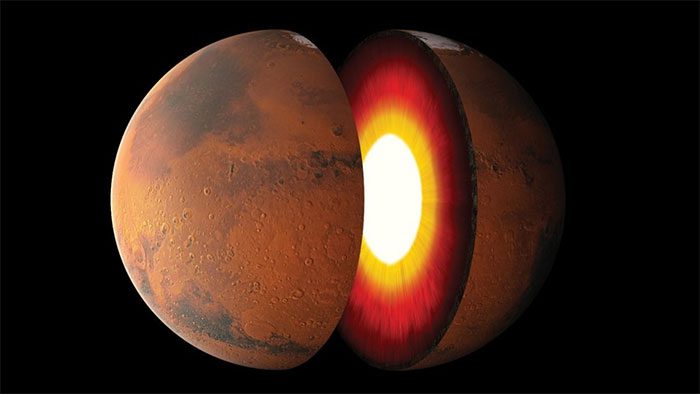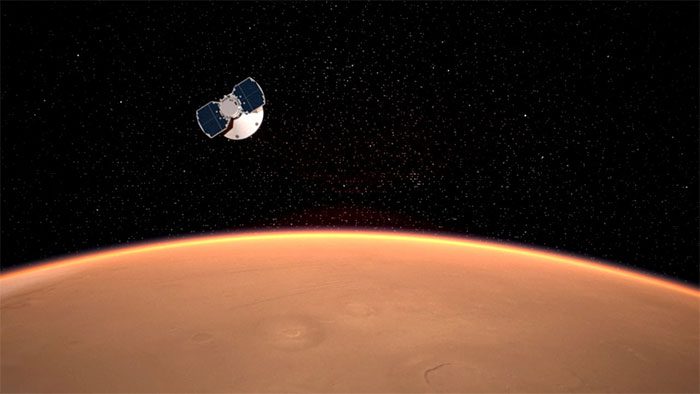According to Science Alert, scientists have discovered that the core of Mars is quite similar to the core of Earth. However, it is more compressible and less dense.
Intense seismic activity on Mars was first detected through its solid core. This provides scientists with various tools to accurately determine what the core of Mars is composed of.
How to Identify the Components of Mars’ Core

Exploring the core of Mars is not an easy process. (Photo: Future).
According to seismic data obtained from NASA’s InSight lander over four years, the center of Mars is a liquid iron alloy, with significant amounts of sulfur and oxygen mixed in.
This information has helped scientists gain a better understanding of Mars’ history and the reasons for the differences between Earth and this planet.
Geologist Vedran Lekic from the University of Maryland stated, “In 1906, scientists first discovered the Earth’s core by observing how seismic waves from earthquakes were affected when passing through the core. More than 100 years later, we are applying our knowledge of seismic waves to Mars. With the InSight lander, we have finally uncovered the contents of Mars’ center and what makes it different from Earth.”
Thus, seismic activity is not merely a rumbling sound from any object. Many scientists now utilize technology to use these sounds like a form of X-ray.
Specifically, seismic waves propagate outward from their source, bouncing around a planet, moon, or star before settling into a state of quiet. Through the process of passing through and reflecting off certain materials, scientists are able to create maps of the internal composition of the object.
Throughout the monitoring period inside Mars, InSight detected hundreds of earthquakes, providing useful information and details. Consequently, scientists were able to compile the first detailed map of Mars’ core and further understand its internal activity.
In 2021, InSight recorded two significant events on Mars: a powerful earthquake and a meteorite impact that shook the Red Planet. These events occurred on the opposite side and quite far from InSight. Therefore, InSight had the opportunity to analyze different types of waves, including those propagating around Mars and those passing through it.
These waves serve to provide information about the density and compressibility of the various materials they traverse, aiding the research team of planetary scientist Jessica Irving from the University of Bristol in gradually uncovering the structure of Mars’ core.
Accordingly, the outer core of Mars is identified as liquid, the inner core as solid, and the innermost core denser. Additionally, there is a very high proportion of light elements mixed into Mars’ core.
Specifically, about one-fifth of its weight is made up of primarily sulfur, with small amounts of oxygen, carbon, and hydrogen. This means that Mars’ core is less dense and more compressible than Earth’s core.

The InSight lander exploring Mars. (Photo: NASA Mars Exploration).
Enhancing the Search for Life Beyond Earth
For a long time, it has been known that Mars does not have a magnetic field across the planet. Meanwhile, on Earth, the magnetic field helps to prevent the atmosphere and water from leaking into space. This phenomenon is known as geodynamo, which is generated in the Earth’s core.
Initially, heat moves from the inner core to the outer core, creating circulating electric currents that twist into different forms through the planet’s rotation. This process generates and maintains the magnetic field.
For Mars, scientists have previously simulated the planet’s core and suggested that the presence of lighter elements in the core may be the reason for the loss of its magnetic field.
“In a way, studying the core of Mars is like solving a puzzle; for instance, there are small traces of hydrogen in Mars’ core. This means there must be certain conditions allowing hydrogen to exist there, and we need to know these conditions to understand how Mars has developed,” said Lekic.
Science Alert notes that discovering the components in Mars’ core could enhance the search for life beyond the Solar System. Mars and Earth are relatively similar in many aspects, so understanding how they differ and the reasons for these differences will narrow down the process of finding planets most likely to harbor life.





















































